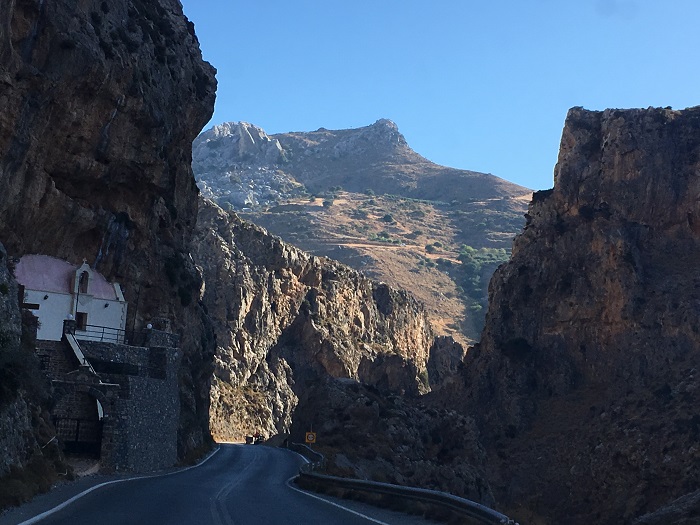
Come time-travel with me as Thor and I drive a rocky passage to the sea, and I flashback to my first Cretan hike down the Gorge of Samaria.
NOTE: Of course, Thor and I had to make another trip to Greece, as he’s fallen as much in love with the islands as I am. This time, in addition to other island-hopping, I wanted to return to Crete after 37 years. My first months-long trip was as a hippie backpacker, camping in the ruins and falling under the spell of the mysterious, vanished Minoan culture. This time, I got to introduce Thor to “glorious Kriti” and research more settings for my novel-in-progress, THE ARIADNE DISCONNECT. This new blog series started October 19, 2019, and will continue every Saturday.
In last week’s post, we delved into the ancient Minoan cemetery of Armeni and marveled at the rich trove of its relics displayed in the Rethymno museum. Then we headed for the south coast in our rental car, where we planned to enjoy some swimming and beach R&R at the laid-back village of Plakias. Crete’s east-west backbone of rugged mountains dictates some circuitous routes, and much of the south coast is not accessible by road, only by boat. Luckily Plakias was a fairly quick drive from the north coast, with the option of two different gorges to follow to reach the shore. We chose the Kourtaliotiko Gorge, its rugged walls looming over the roadway and dropping to an almost-dry stream bed. (It was late September; in the winter and spring the stream would be rushing.)
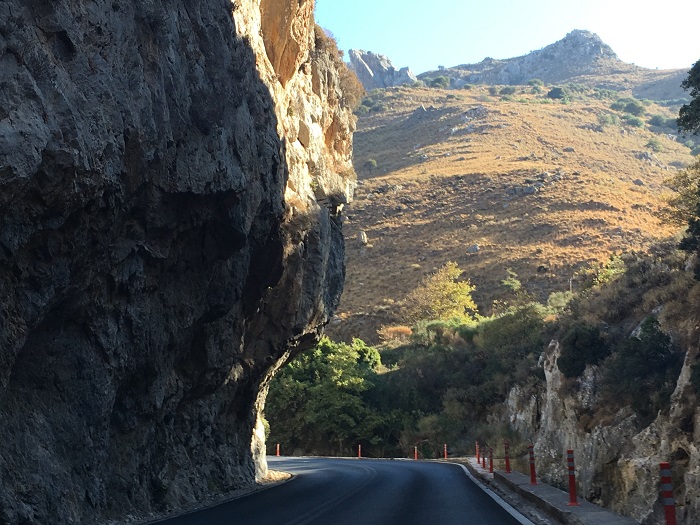
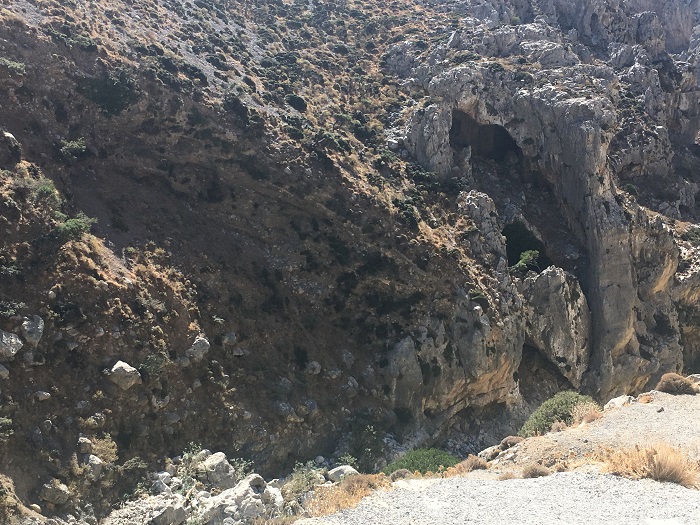
As always when driving the sometimes terrifying Greek mountain roads, we made sure we had our “evil eye protection” blue bead hanging from the rear-view mirror.
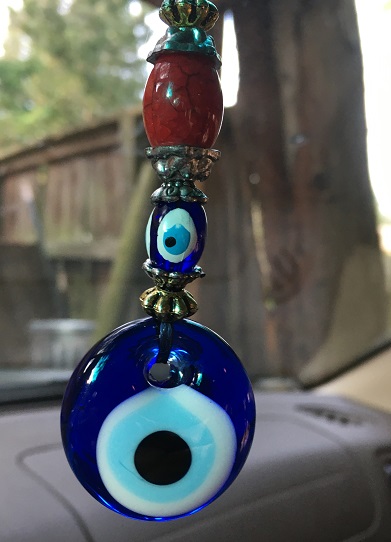
This gorge featured not one, but three roadside shrines, which can be erected by anyone to honor a loved one perhaps killed in an accident, or simply to petition a saint for protection from dangerous roads and crazy drivers. The top blog photo shows a closeup of the rather amazing shrine and chapel built into the cliff. Greeks are always repurposing their ubiquitous caves!
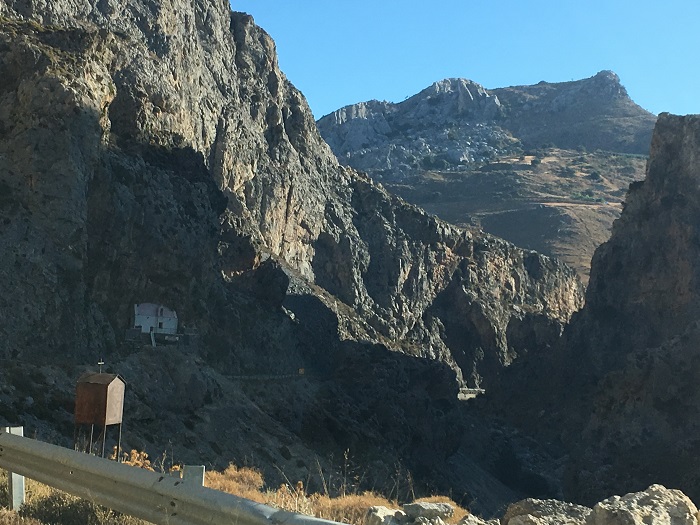
As we glimpsed the sea opening up below the gorge, I was suddenly transported in time to my stormy hike down the roadless Gorge of Samaria 37 years earlier. Join me now, if you like, as I revisit that hike via journal entries and some blurry old photos:
Crete is a surprisingly rugged island, and the Cretans take great pride in their toughness that reflects the terrain.
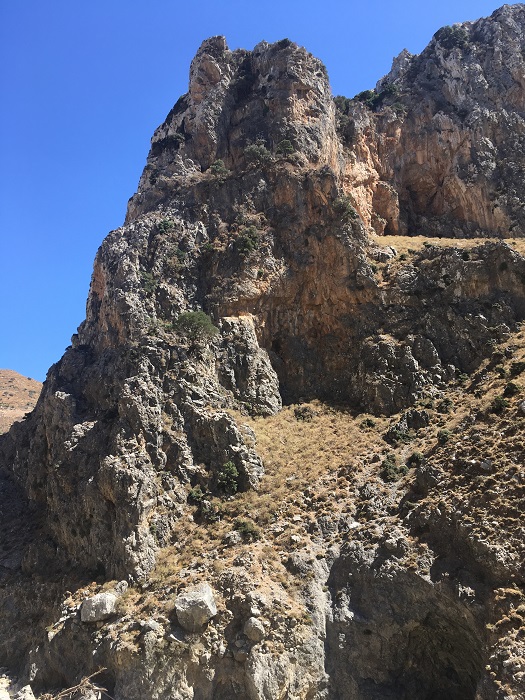
Snowy mountains run east to west and fall steeply in the south to rocky shorelines cut by deep coves of crystal-clear blue water. The Gorge of Samaria is the second longest in Europe at 16 kilometers, a sometimes challenging hike from the mountain pass through narrow canyons that funnel icy mountain springs to eventually empty into the Mediterranean.
On a late April early morning, my partner Jim and I took an aged bus from Chania on the north coast, through lovely valleys south toward the mountains. From my journal:
The road is very narrow, and every time we approach a turn, the driver blasts his horn. We pass through green, terraced fields, small villages with whitewashed houses with always blue-painted doors and shutters. Lots of vineyards and olive orchards, with yellow and blue flowers, pink cherry blossoms, and the glowing scarlet wild poppies.
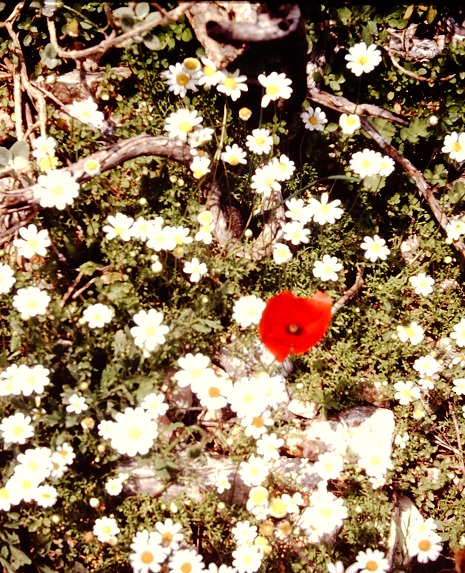
Then we start climbing. The White Mountains — Lefka Ori — loom over us, very close and forbidding with their cold breath of lingering snow. Everything turns to bare rock—crags and piles of boulders, rough and jagged stones, with here and there a pasture cleared between fences made of these same rocks. The driver enjoys scaring his passengers as he grins and blasts the horn and swings the bus over to the very edge to manage the tight twists and turns, and we peer straight down for sickening drops to narrow gorges. Strings of protective beads and holy icons swing from the rear-view mirror.
Halfway there, we pass through the village of Laki, clinging precariously to the foothills, the whitewashed houses stacked one above the other, the church overlooking them from a craggy bluff, its blue dome shining in the sun. A white dove floats up the valley, catching the light.
Departing from the bus at the end of the mountain road, we shouldered our backpacks and headed down the rocky trail in a ravine. Snowmelt springs tumbled down the cliffs past clinging pines and twisted small-leaf maples. Blue-tinted deep pools in the rocky gorge held crystal-clear, sweet water for drinking. As we hiked down the steep, beautifully wild gorge, we spotted a rare kri-kri, a native wild goat.
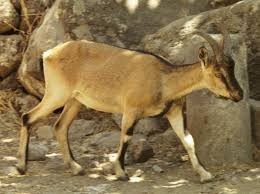
(photo from WikimediaCommons)
After several kilometers, the trail leveled into a narrow valley containing the ruins of the settlement of Samaria, where we rested for lunch. Then it was down into the lower gorge, where the rocky walls narrowed in places almost allowing us to touch both walls with our outstretched arms.
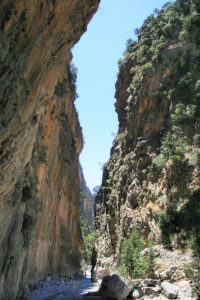
(photo from WikimediaCommons)
In the afternoon, clouds lowered with a promise of rain, the walls closing into a gloomy dark tunnel. The stream swelled to fill the ravine, forcing us to make the first of several fordings through the icy, rushing water that almost knocked me over with my heavy backpack.
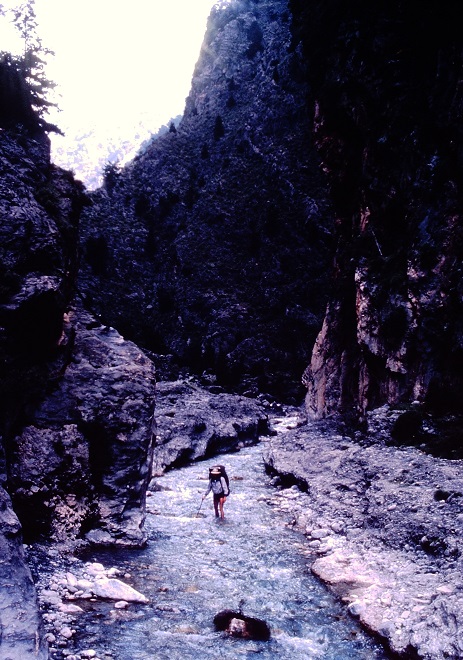
Above is Jim at a shallower crossing. Here I am on a later trail, carrying my insanely huge backpack. A goat herder who walked along a rocky trail with us gave me the “heroic epithet” of “Sara Kri-Kri,” of which I was ridiculously proud.
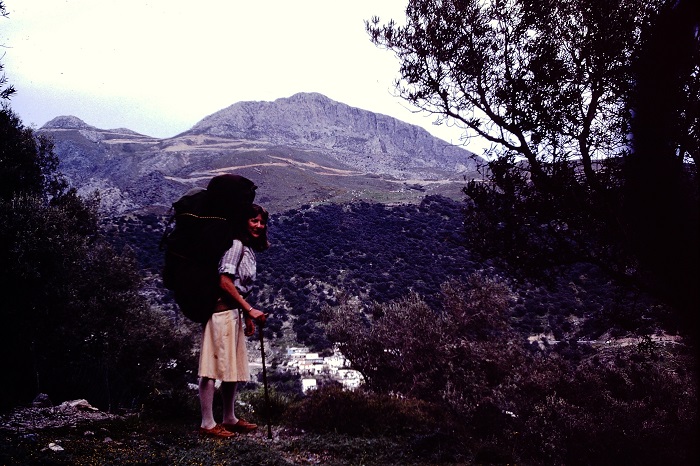
In places in the Samaria Gorge, we were clinging to the rocky walls and trying not to slip into the torrent, which inspired a scene in The Ariadne Connection:
The first physical [earthquake] tremors started when they were halfway up the ravine. The dirt track had given way to a narrow trail climbing stony switchbacks above the village, then to a steeper goat path.
Following Cassandra’s surprisingly nimble, knotted old legs through an inward fold of the rising mountains, Ariadne looked down to the stream making its way past the broken rock foundations of a ruined settlement. High above it on a craggy bluff, the square tower and blank window slits of a centuries-abandoned Venetian fortress frowned down. On their side of the stream, above the precarious path ledge, natural caves honeycombed the limestone cliffside. Vanished hermit-monks had built plastered walls to seal their entrances, and outside one black-shadowed doorway a few bright scraps of laundry lay spread over the rock. When Ariadne paused to point at the cave—“Your home?”—the crone only nodded and prodded her on with the staff.
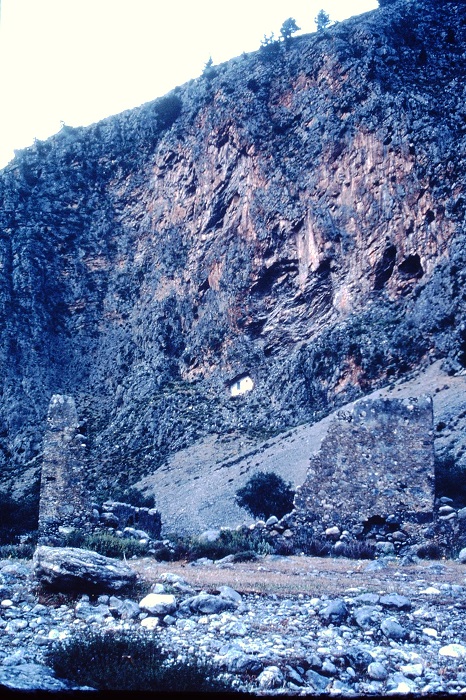
The pathway narrowed again as they climbed. They were forced to wade up the stream bed itself, slippery stones shifting under the foaming snowmelt from the peaks. The ravine sealed off all but a thin strip of blue far above, sheer cliffs closing in so tightly Ariadne could touch both sides with her outstretched fingers.
She could taste the urgency in the air. The shrill scream of blocked pressures ripped through her bones. Panting, she followed the midwife through the churning current, slipping over wet stones and nearly going under before she caught the staff the old woman stretched out to her from a steep bank.…
As daylight waned on our hike, a cloudburst drove Jim and me to seek shelter under an overhanging boulder and ponder our options, as we’d planned to find flat ground near the seashore to camp, and there was only steep rock here. It was getting dark as we searched for a possible campsite, and then came upon a small, abandoned chapel in the dusk. Another cloudburst had us scurrying into the musty chapel, where we lit candles below some faded icons that had been painted on the whitewashed walls.
We were just unpacking the meager remains of our lunch—we’d planned to reach a taverna at the bottom of the trail for dinner—a drenched couple sprinted out of the gloom and into the chapel beside us. Olga and Georges were Belgians who spoke no English, but I dusted off my junior high school French, and we managed to communicate. They were day hikers and had no bedding, so we loaned them our sleeping pads and we shared our leftover bread and halvah, along with their tomato and mackerel salad. The shared laughter and comradery of strangers in the storm made it an ambrosial meal to remember.
This is a photo that Olga and Georges sent us later: Jim and I the next morning, as we waited for the stream to subside so we could finish the hike to the sea.
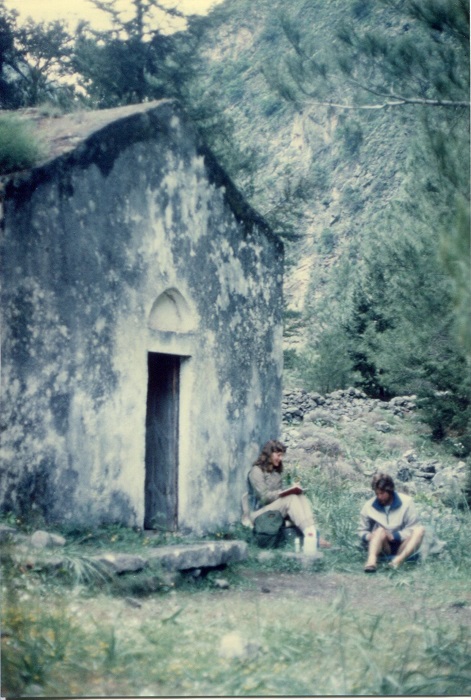
As we hiked on and finally neared our destination at the coast, we passed the remains of an ancient stone “bridge to nowhere.” We had arrived.
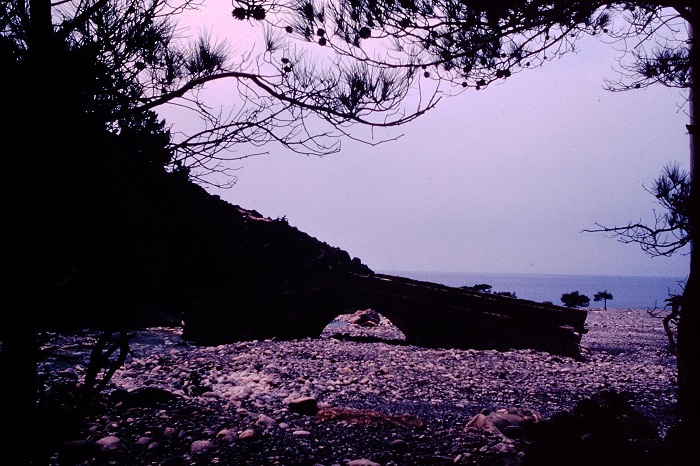
(Now blinking and returning to the car with Thor:)
We were happy to emerge from our own rocky gorge passage into the gentler strip of valley above the coast, not so much the back of beyond as what that old bridge spanned, but offering us the welcome of a room with a bed. Thor and I are quite happy these days to trade a tent and rocky ground for a roof and mattress! Next week: Plakias and swimming the magical clear Mediterranean.
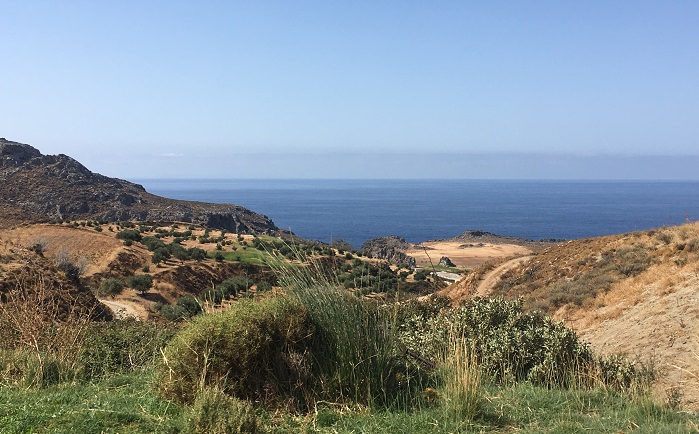
*****
You will find The Rambling Writer’s blog posts here every Saturday. Sara’s latest novel from Book View Cafe is available in print and ebook: The Ariadne Connection. It’s a near-future thriller set in the Greek islands. “Technology triggers a deadly new plague. Can a healer find the cure?” The novel has received the Chanticleer Global Thriller Grand Prize and the Cygnus Award for Speculative Fiction. Sara has recently returned from another research trip in Greece and is back at work on the sequel, The Ariadne Disconnect. Sign up for her quarterly email newsletter at www.sarastamey.com

1 thought on “The Rambling Writer Returns to Crete, Part 3: Gorges of South Crete”